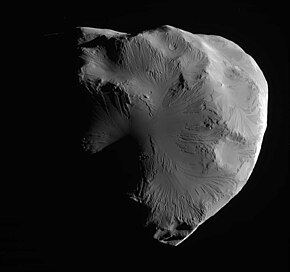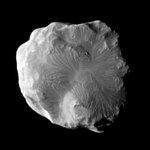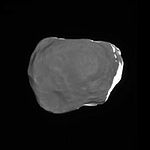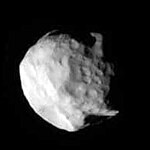Helene (moon) (original) (raw)
From Wikipedia, the free encyclopedia
Trojan moon of Saturn
Helene
 High-resolution view of leading hemisphere, showing gullies and apparent dust (regolith) flows (Cassini, June 2011) High-resolution view of leading hemisphere, showing gullies and apparent dust (regolith) flows (Cassini, June 2011) |
|
|---|---|
| Discovery[1] | |
| Discovered by | P. LaquesJ. Lecacheux |
| Discovery site | Pic du Midi Observatory |
| Discovery date | March 1, 1980 |
| Designations | |
| Designation | Saturn XII |
| Pronunciation | [2] |
| Named after | Helen of Troy (Ἑλένη Helenē) |
| Alternative names | Dione B S/1980 S 6 |
| Adjectives | Helenean [3] |
| Orbital characteristics | |
| Semi-major axis | 377600 km[4] |
| Eccentricity | 0.007[4] |
| Orbital period (sidereal) | 2.736916 d[4] |
| Inclination | 0.199° (to Saturn's equator) |
| Satellite of | Saturn |
| Group | L4 Dione trojan |
| Physical characteristics | |
| Dimensions | 45.2 × 39.2 × 26.6 km(± 0.4 × 0.6 × 0.4 km)[5] |
| Mean diameter | 36.2±0.4 km[5] |
| Volume | 24840 km3[a] |
| Mass | (7.1±0.2)×1015 kg[6] |
| Mean density | 0.2926±0.0217 g/cm3[6] |
| Surface gravity | 0.0009 m/s2 at longest axisto 0.0027 m/s2 at poles |
| Escape velocity | 0.0065 km/s at longest axisto 0.0084 km/s at poles |
| Synodic rotation period | assumed synchronous |
| Axial tilt | zero |
| Albedo | 1.67±0.20 (geometric)[7] |
Helene is a moon of Saturn. It was discovered by Pierre Laques and Jean Lecacheux in 1980 from ground-based observations at Pic du Midi Observatory,[1] and was designated S/1980 S 6.[8] In 1988 it was officially named after Helen of Troy, who was the granddaughter of Cronus (Saturn) in Greek mythology.[9] Helene is also designated Saturn XII (12), which it was given in 1982, and Dione B,[10] because it is co-orbital with Dione and located in its leading Lagrangian point (L4). It is one of four known trojan moons.
Animation of Helene's orbit relative to Saturn and Dione
Polydeuces · Helene · Dione · Saturn
Helene was initially observed from Earth in 1980,[8] and Voyager flybys of Saturn in the early 1980s allowed much closer views. The Cassini–Huygens mission, which went into orbit around Saturn in 2004, provided still better views, and allowed more in-depth analysis of Helene, including views of the surface under different lighting conditions. Some of the closest images of Helene to date are from the Cassini spacecraft's 1800 km flyby on March 3, 2010, and another very successful imaging sequence occurred in June 2011. There were many other approaches over the course of the Cassini mission.
Images of Helene taken by the Cassini spacecraft, with resolutions of up to 24 meters per pixel, show a landscape characterized by broad 2–10km scale depressions with interior slopes no greater than 12°.[11] These basins are likely the decayed remains of old impact craters.[12]
Thin, elongated km-scale raised grooves trace the slopes of many of Helene's basins, likely representing mass flow features and indicating that the moon is undergoing active geologic processes such as mass-wasting and erosion. Digital elevation models suggest that the grooves have a positive relief of between 50 and 100 meters. Helene has more than 70 craters, while it shows a bimodal appearance—the heavily cratered trailing hemisphere exhibits a crater density ten times greater than the smooth-looking leading hemisphere.[11]
Simulation models show that the time series of surface activity on Helene is chaotic.[_citation needed_]
Helene's surface material is of relatively high reflectance, suggesting grain sizes between 1 and 100 micrometers. Small craters appear somewhat buried, suggesting recent accretional processes of some sort.
Stress-strain laboratory testing of impact-gardened lunar regolith samples shows that at low packing densities, they behave like Non-Newtonian “Bingham” materials, i.e., having the plastic quality of candle-wax and glaciers. This observation suggests that Helene's snow-like surface material may behave as a non-Newtonian mass flow and could be primarily responsible for the visible flow patterns seen on its low-gravity surface.[12]
Selected observations
[edit]
Mostly raw greyscale images with near infrared or ultraviolet channels.

Flow-like features on Helene's leading hemisphere (Cassini, January 2011)
Image of Helene against the backdrop of Saturn's clouds (Cassini, March 3, 2010)
Helene's Saturn-facing side, lit by saturnshine (Cassini, March 2010)
Close-up of Helene with Saturn in the background (Cassini, March 2010)
Cassini image from March 3, 2010
Cassini orbiter image from November 2008
Cassini image taken July 2007
Voyager 2 image (August 1981)
^ Calculated from Helene's volume-equivalent sphere radius of 18.1±0.2 km given by Thomas et al. (2020)[5]
^ a b Lecacheux1980.
^ John Walker (1839) A Critical Pronouncing Dictionary and Expositor of the English Language;
also per "Helena". Oxford English Dictionary (Online ed.). Oxford University Press. (Subscription or participating institution membership required.)^ Clarified as Helenéan in Earle (1841) Marathon: and other poems, p. 76.
^ a b c "Planetary Satellite Mean Orbital Parameters". Jet Propulsion Laboratory. Retrieved 5 June 2023.
^ a b c Thomas & Helfenstein 2020, p. 2.
^ a b Jacobson 2022, p. 6.
^ Transactions of the International Astronomical Union, Vol. XVIIIA, 1982 (mentioned in IAUC 3872: Satellites of Jupiter and Saturn, September 30, 1983
^ a b Hirata et al. 2014.
Sources
- Lecacheux, Jean. (July 1980). "A new satellite of Saturn: Dione B". Icarus. 43 (1): 111–115. Bibcode:1980Icar...43..111L. doi:10.1016/0019-1035(80)90093-7.
- Marsden, Brian G. (July 31, 1980). "Satellites of Saturn" (discovery). IAU Circular. 3496. Retrieved 2011-12-23.
- Marsden, Brian G. (September 30, 1983). "Satellites of Jupiter and Saturn". IAU Circular. 3872. Retrieved 2011-12-23.
- Marsden, Brian G. (June 8, 1988). "Satellites of Saturn and Uranus" (naming). IAU Circular. 4609. Retrieved 2011-12-23.
- Thomas, P. C. (July 2010). "Sizes, shapes, and derived properties of the saturnian satellites after the Cassini nominal mission" (PDF). Icarus. 208 (1): 395–401. Bibcode:2010Icar..208..395T. doi:10.1016/j.icarus.2010.01.025. Archived from the original (PDF) on 2018-12-23. Retrieved 2015-09-04.
- Hirata, N. (May 27, 2014). "Particle deposition on the saturnian satellites from ephemeral cryovolcanism on Enceladus". Geophysical Research Letters. 41 (12): 4135–4141. arXiv:2205.11265. Bibcode:2014GeoRL..41.4135H. doi:10.1002/2014GL060470. Retrieved 2024-03-04.
- Thomas, P. C.; Helfenstein, P. (July 2020). "The small inner satellites of Saturn: Shapes, structures and some implications". Icarus. 344: 20. Bibcode:2020Icar..34413355T. doi:10.1016/j.icarus.2019.06.016. S2CID 197474587. 113355.
- Jacobson, Robert A. (November 2022). "The Orbits of the Main Saturnian Satellites, the Saturnian System Gravity Field, and the Orientation of Saturn's Pole". The Astronomical Journal. 164 (5): 19. Bibcode:2022AJ....164..199J. doi:10.3847/1538-3881/ac90c9. 199.
- Umurhan, O. M.; Howard, A. D.; Moore, J. M.; Schenk, P.; White, O. L. (2015). Reconstructing Helene's Surface History – Plastics and Snow (PDF). 46th Lunar and Planetary Science Conference. Retrieved 2021-02-12.
- Verbiscer, A.; French, R.; Showalter, M.; Helfenstein, P. (9 February 2007). "Enceladus: Cosmic Graffiti Artist Caught in the Act". Science. 315 (5813): 815. Bibcode:2007Sci...315..815V. doi:10.1126/science.1134681. PMID 17289992. S2CID 21932253. (supporting online material, table S1)
Wikimedia Commons has media related to Helene.
![]()
This audio file was created from a revision of this article dated 6 February 2010 (2010-02-06), and does not reflect subsequent edits.
- Helene Profile by NASA's Solar System Exploration; see instead Cassini Solstice Mission: Helene
- The Planetary Society: Helene
- Helene has two faces Archived 2010-06-16 at the Wayback Machine—The Planetary Society : Helene Mini Atlas—Mar. 11, 2010
- Cassini catches Helene Archived 2012-04-01 at the Wayback Machine—The Planetary Society : Video & Views—Jun. 20, 2011

